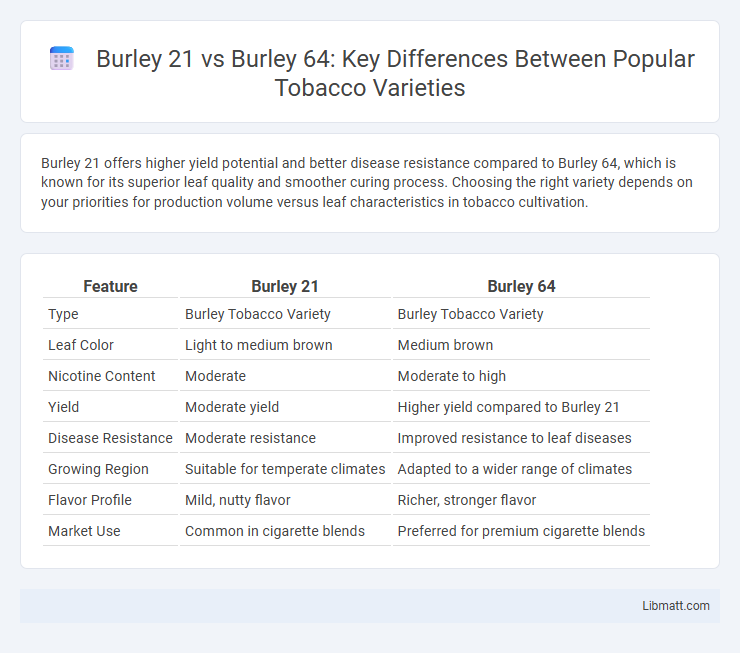Burley 21 offers higher yield potential and better disease resistance compared to Burley 64, which is known for its superior leaf quality and smoother curing process. Choosing the right variety depends on your priorities for production volume versus leaf characteristics in tobacco cultivation.
Table of Comparison
| Feature | Burley 21 | Burley 64 |
|---|---|---|
| Type | Burley Tobacco Variety | Burley Tobacco Variety |
| Leaf Color | Light to medium brown | Medium brown |
| Nicotine Content | Moderate | Moderate to high |
| Yield | Moderate yield | Higher yield compared to Burley 21 |
| Disease Resistance | Moderate resistance | Improved resistance to leaf diseases |
| Growing Region | Suitable for temperate climates | Adapted to a wider range of climates |
| Flavor Profile | Mild, nutty flavor | Richer, stronger flavor |
| Market Use | Common in cigarette blends | Preferred for premium cigarette blends |
Introduction to Burley 21 and Burley 64 Varieties
Burley 21 and Burley 64 are prominent tobacco varieties known for their distinctive growth characteristics and leaf quality. Burley 21, developed for higher yield and disease resistance, is favored in bulk tobacco production, while Burley 64 is prized for its finer leaf texture and stronger flavor profile, making it ideal for premium cigarette blends. Both varieties contribute significantly to the Burley tobacco market but cater to different agricultural and manufacturing preferences.
Historical Background of Burley 21 and Burley 64
Burley 21, developed in the 1940s, marked a significant advancement in tobacco breeding by offering improved disease resistance and higher yield compared to earlier varieties. Burley 64 emerged decades later, incorporating genetic enhancements for even greater durability and leaf quality, making it a preferred choice among modern growers. Understanding the historical evolution of these varieties can help you select the best Burley tobacco for your cultivation needs.
Genetic Characteristics and Differences
Burley 21 exhibits a higher nicotine content and a more robust disease resistance profile compared to Burley 64, which is known for its lower alkaloid levels and increased yield potential. Genetically, Burley 21 carries dominant alleles that enhance its drought tolerance, whereas Burley 64 features gene variants linked to improved leaf quality and curing traits. Your choice between these varieties should consider the balance between nicotine strength and cultivation efficiency based on these genetic distinctions.
Growth and Agronomic Practices
Burley 21 and Burley 64 tobacco varieties differ significantly in growth habits and agronomic practices, with Burley 21 exhibiting moderate vigor and requiring standard nitrogen fertilization, while Burley 64 demonstrates higher vigor and responds well to increased nitrogen levels for optimal leaf yield. Burley 64 typically has a longer growing season and better tolerance to pest stress, necessitating tailored irrigation and pest management schedules compared to Burley 21. Farmers adjusting crop density and pruning techniques can enhance Burley 64's leaf quality, whereas Burley 21 benefits from balanced nutrient management to maintain consistent leaf texture.
Disease Resistance Comparison
Burley 21 exhibits moderate resistance to key tobacco diseases such as black shank and blue mold, making it a reliable choice for growers in regions prone to these pathogens. Burley 64 offers enhanced resistance, particularly against root-knot nematodes and tobacco mosaic virus, improving crop sustainability and yield quality. Your selection between Burley 21 and Burley 64 should consider the specific disease pressures in your cultivation area to maximize plant health and productivity.
Yield Performance: Burley 21 vs Burley 64
Burley 21 offers moderate yield performance with consistent leaf quality, making it suitable for stable production environments. Burley 64, however, is known for its higher yield potential, often outperforming Burley 21 in both leaf weight and overall biomass. You can expect Burley 64 to maximize output on fertile soils where increased leaf production is desired.
Leaf Quality and Curing Results
Burley 21 offers a medium leaf quality characterized by uniform texture and moderate oil content, resulting in a balanced curing process that enhances flavor retention and smoothness. In contrast, Burley 64 produces leaves with higher brightness and increased elasticity, which contribute to faster curing times and improved resistance to mold during storage. Your choice between these varieties should consider the desired curing efficiency and end-product quality, as Burley 64 typically yields a more vibrant cured leaf while Burley 21 emphasizes a richer aromatic profile.
Market Demand and Economic Value
Burley 64 typically commands higher market demand due to its superior leaf quality and larger yield potential compared to Burley 21, making it more economically valuable for growers targeting premium tobacco markets. Burley 21, while less in demand, offers lower input costs and faster maturation, appealing to farmers seeking reduced production expenses. Your choice between these varieties will significantly impact profitability depending on market preferences and production goals.
Suitability for Different Climates and Regions
Burley 21 thrives in temperate climates with moderate rainfall, showing strong resistance to fungal diseases common in such regions, making it ideal for parts of the southeastern United States. Burley 64 is better suited for subtropical and warmer regions, exhibiting enhanced drought tolerance and heat resistance, which supports stable yields in areas with hotter, drier conditions like parts of the southern U.S. Both varieties require well-drained soils, but Burley 64's adaptability to stress conditions expands its cultivation range beyond the more climate-sensitive Burley 21.
Choosing the Right Burley Variety: Key Considerations
When choosing between Burley 21 and Burley 64 varieties, consider their distinct growth characteristics and flavor profiles that impact your tobacco crop's quality and yield. Burley 21 typically offers a milder taste with a balanced nitrogen uptake, making it suitable for lighter blends, while Burley 64 is known for its robust flavor and higher nicotine content favored in stronger tobacco products. Your selection should align with your cultivation environment, desired tobacco strength, and market demand to optimize both plant performance and consumer satisfaction.
Burley 21 vs Burley 64 varieties Infographic

 libmatt.com
libmatt.com